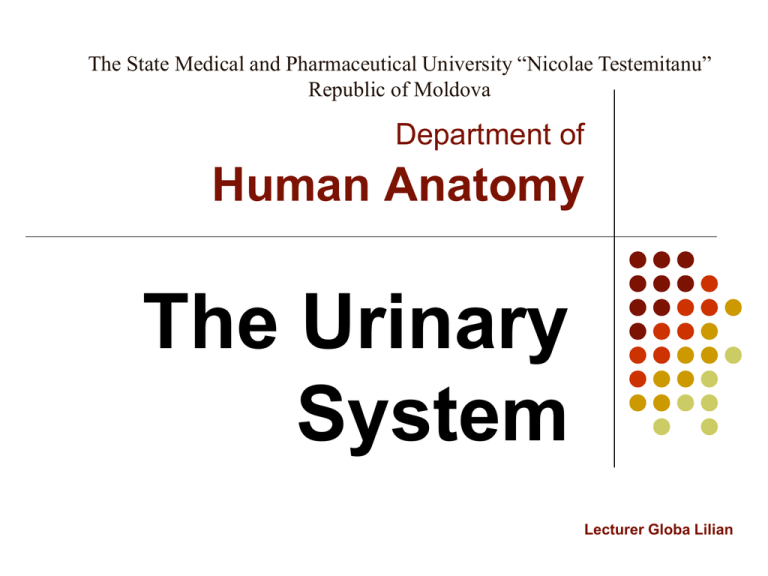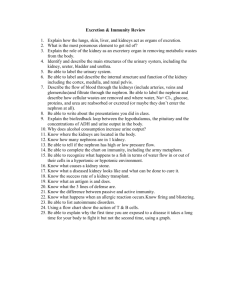Human Anatomy The Urinary System
advertisement

The State Medical and Pharmaceutical University “Nicolae Testemitanu” Republic of Moldova Department of Human Anatomy The Urinary System Lecturer Globa Lilian Uro-genital Apparatus Urinary System for secretion and discharge of the urine Genital System concerned with process of reproduction Have common sources and ways of the development, topographic sites, blood and nerve supply Overview of the Urinary System 4 components Functions Controlling the water and electrolyte balance, maintain the acid-base balance Regulates blood concentrations of sodium, potassium, chloride and calcium Regulates blood volume and blood pressure Production of urine- waste products (urea and uric acid) Reabsorb important nutrients from urine Endocrine (rennin, angiotensin, erythropoietin) Anatomy 1. Kidney Each kidney is about: Length 11.25 cm Breadth 5-7.5 cm Width 2.5 cm The weight: Male 125-175 g Female 115-155 g Anatomy 2. Ureter * Connects kidney to urinary bladder Anatomy 3. Urinary bladder * Stores urine Anatomy 4. Urethra * Drains urine from bladder Coverings of the Kidneys The kidneys have the following coverings: Fibrous capsule Perirenal fat Renal fascia with anterior and posterior layers Pararenal fat Fixation of the Kidneys The elements that held kidneys in position: Peri- and para renal fat Renal fascia with anterior and posterior layers Vascular pedicle Intrabdominal pressure Anatomy of the Kidney Outer cortex Inner medulla Medulla Medulla divided into pyramids and columa renalis One pyramid with corresponding cortex form renal lobe Cortex Cortex divided into pars convoluta and pars radiata Calyx One minor calyx per pyramid Minor Calyx Major Calyx Fusion of several minor calyces Usually 2-3 major calyces per kidney Fornical Apparatus Renal Pelvis Fusion of major calyces Opening to the ureter Human Kidney Urogram The Nephron Basic structural and functional unit of kidney The Nephron Filtration of blood Production of urine 1,25 million per kidney 85 miles of tubes per kidney Components of Nephron Renal corpuscle: 1. a. b. 2. 3. 4. Glomerulus – a net-work of convoluted capillaries Glomerular (Bowman’s) capsule – a hollow chamber surrounding the glomerulus Proximal convoluted tubule Loop of Henle (descending and ascending limbs) Distal convoluted tubule The Nephron The Nephron Epithelia filter the urine Glomerulus Glomerulus and Capsule efferent arteriole urine afferent arteriole Proximal Convoluted Tubule Loop of Henle only part found in medulla The Juxtaglomerular Apparatus efferent arteriole urine afferent arteriole Distal Convoluted Tubule Collecting (Straight) Duct Collecting Duct Not part of nephron Collects urine from distal convoluted tubules of many nephrons Opens at tip of pyramid Urine drains into minor calyx Collecting Duct Important Relations, Right Kidney Anteriorly: the suprarenal gland, the liver, the descended part of the duodenum, coils of jejunum, the right colic flexure. Posteriorly: the diaphragm, the XII-rib, the psoas, quadratus lumborum, and transversus abdominis muscles (the renal lodge) the costodiaphragmal recess of pleura, the subcostal, iliohypogastric and ilioinguinal nerves Important Relations, Left Kidney Anteriorly: the suprarenal gland, the spleen, the stomach, the pancreas, coils of jejunum, the left colic flexure. Posteriorly: the diaphragm, the XI-XII rib, the psoas, quadratus lumborum, and transversus abdominis muscles (the renal lodge) the costodiaphragmal recess of pleura, the subcostal, iliohypogastric and ilioinguinal nerves Anterior Relation of both Kidneys 1 – area hepatica; 2 – area colica; 3 – area jejunalis; 4 – area duodenalis; 5 – glandulae suprarenales; 6 – aa. renales; 7 – vv. renales; 8 – area gastrica; 9– area lienalis; 10 – area pancreatica; 11– area colica. Ureter Drains urine from kidney to urinary bladder Length 25-30 cm Four parts: 1. Abdominal 2. Pelvic 3. Intramural 4. Intravesical Ureter Three constrictions: 1. Ureteropelvic 2. Iliac 3. Ureterovesical Urinary Bladder Surfaces: *Posterior (fundus or base) *Anterior (contacts with pubic symphysis and retropubic space of Retzius ) *Superior (covered by peritoneum) Apex continues with median umbilical ligament Neck contains internal urethral sphincter ureter opens into posterior wall of bladder Internal urethral Sphincter External urethral Sphincter Urinary Bladder -- Male Urinary Bladder -- Female Development of the kidney Three sets of structures appear during the development of the urinary system: 1. Pronephros 2. Mesonephros (Mǖllerian Duct) 3. Metanephros (responsible for permanent kidney) arise from two sources: Ureteric Bud Metanephrogenic Cup • • • • • • Glomerular capsule (covers a cluster of capillaries - Glomerulus ) • Proximal • Loops of Henle • Distal convoluted tubules Ureter Pelvis Major Calyces Minor Calyces Collecting Tubules Abnormalities VĂ MULȚUMESC PENTRU ATENȚIE!






